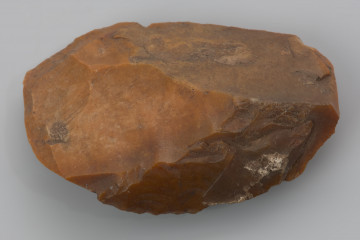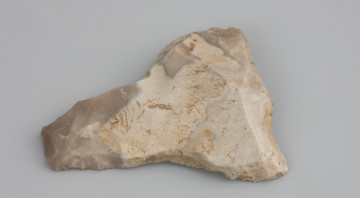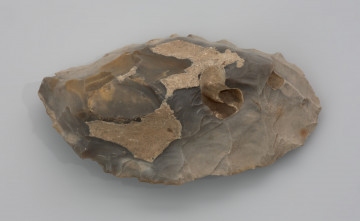
Flake axe
9600 p.n.e. — 4100 p.n.e.
National Museum in Szczecin
Part of the collection: Stone Age
The slate axe from Unimie near Łobez comes from a collection of artefacts discovered in 1931 on dunes, on a site from different Palaeolithic and Mesolithic periods. The tool was made from a sizeable piece chipped off chalk flint of very high quality. It can be assumed with high probability that it was a pre-defined flake, the shape of which had already been determined before it was removed from the core, i.e., a lump of raw material intended to extract semi-raw material, which was then processed into a pre-defined tool. The process of manufacturing the axe consists in reducing the bottom and top sides of the flake to obtain the desired shape. In this case, the maker made very skilful use of the natural surfaces of the block, which allowed for simplifying the whole process. It is worth noting that other macro-lithic tools found at the same site in Unimie were made in the same manner. Although axes are multifunctional tools, they are most often combined with woodworking. Such tools (or, more broadly, macro-liths as the whole family of extensive Mesolithic tools) were used when set in frames made of various organic materials, such as antlers, bone and wood. They are, therefore, the so-called composite tools. From the point of view of hunter-gatherer communities leading nomadic lifestyles, it was essential to save raw materials and limit the number and volume of tools carried from place to place. For example, depending on the nature of the work, a pickaxe and axe could be embedded in the same cast. On the other hand, depending on the type of cast in which it was embedded, the same flint axe could be used as, e.g., a pick, axe or chisel, as was the presented tool from Unimie.
Michał Adamczyk
Author / creator
Dimensions
cały obiekt: height: 6.7 cm, width: 2.1 cm
Object type
axe (mesolithic tool)
Technique
carving, hard masher carving
Material
flint, stone
Origin / acquisition method
acquisition
Creation time / dating
Creation / finding place
Owner
National Museum in Szczecin
Identification number
Location / status

9600 p.n.e. — 4100 p.n.e.
National Museum in Szczecin

9600 p.n.e. — 9000 p.n.e.
National Museum in Szczecin

9600 p.n.e. — 5400 p.n.e.
National Museum in Szczecin
DISCOVER this TOPIC
Museum of King Jan III's Palace at Wilanów
DISCOVER this PATH
Educational path